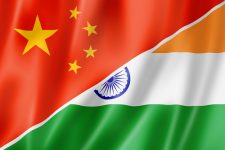The Ongoing China-India Border Stand-off Is Escalating

Tensions are mounting over the China-India border stand-off in the Himalayas, as Chinese troops have begun conducting live-fire drills in the contested area. The almost six-week long dispute is occurring in the tri-junction border point between China, Bhutan, and the Indian region of Sikkim.
During a press conference on Monday, China’s defence ministry spokesperson Colonel Wu Qian warned India not to “push your luck” by underestimating his country’s “determination and resolve to safeguard national security and sovereignty.”
The dispute was sparked in early June when China began extending a road southward from Yadong in Tibet through a plateau known as Doklam in India and Donglang in China. Beijing claims sovereignty over the area, however, the Himalayan kingdom of Bhutan says it’s within their jurisdiction.
Between two giants
India sent its troops into the area after Bhutan requested its support. Delhi recognises the Bhutanese claim over the Doklam region, and the two nations are close allies. However, Beijing and Thimphu have no formal diplomatic ties.
The construction of the road is also of strategic concern for India, as it would give China greater access to what’s referred to as India’s “chicken’s neck,” which is a 20 kilometre wide corridor that links the nation’s seven remote north-eastern states with the mainland.
The nuclear powers have amassed around 300 soldiers each stationed at about 150 meters apart in the border region. Last month, Indian foreign minister Sushma Swaraj said that both sides need to withdraw their troops. But, Mr Wu said on Monday that Delhi must correct its mistake and withdraw first.
The Sino-Indian war
This is not the first time the two most populous countries in the world have found themselves at loggerheads in the remote region. India and China fought a border war over the disputed terrain back in 1962.
Thousands were killed during the Sino-Indian war, in which India was ultimately defeated. Over recent days, the Chinese state-controlled People’s Daily republished its 1962 editorial that warned it would “not tolerate the provocation by the Indian army” just days before the fighting broke out.
Indeed, analysts have pointed out that just as China gave adequate warning prior to the use of force in 1962, it seems that Beijing is once again employing the same tactic.
Beijing’s long-term claims
China’s foreign ministry spokesman Lu Kang said on June 27 that the area the road is being constructed on is “undoubtedly” on the Chinese side of the border, as this was established when China signed an 1890 treaty with the British government.
The Chinese Communist Party (CCP) has had designs on several Himalayan regions since its inception. Standing in Beijing’s Tiananmen Square in the 1950s, Mao Zedong outlined his theory of China’s right hand, and its detached five fingers that need to be liberated and re-joined.
The revolutionary leader said that Tibet was the nation’s right hand, and its five fingers were the countries of Nepal and Bhutan, and what are now the Indian states of Ladakh, Sikkim, and Arunachal.
Since 1984, the governments of China and Bhutan have held 24 rounds of talks about the territorial claims over the Doklam plateau. Beijing has told Thimphu that no progress over the issue will be made until the kingdom allows the Chinese government to open up a consulate in the country.
Occupied Tibet
Amid the ongoing hostilities, Lobsang Sangay, president of the Central Tibetan Administration was photographed standing on Indian soil in front of the Tibetan flag at Pang Gong lake in Ladahk.
This is another area of land along the disputed Line of Actual Control between the nations of India and China, and it is close to the region that was formerly the independent nation of Tibet.
The CCP began its invasion of Tibet in 1950. By the end of the decade, the entire nation was under the control of Beijing. On March 10 1959, the Tibetan Uprising broke out in the capital of Lhasa, when hundreds of thousands of local people surrounded the Potala Palace.
The uprising was brutally suppressed by Chinese troops, and a week later the Dalai Lama fled Tibet, which led to a mass exodus of about 85,000 Tibetans.
In December last year, China warned India to respect its interests after the Dalai Lama attended a conference of Nobel laureates and shared the stand with then Indian president Pranab Mukherjee. It was the first time the Tibetan spiritual leader and the head of the Indian state had met in decades.
Tit for tat diplomacy
Indian military officials said that troops were moved into the region to call a halt to the construction of the road. The soldiers moved in and created a human wall in front of the Chinese construction team.
Beijing claims that in doing so the Indian troops trespassed on their terrain and obstructed normal activities. In response Chinese troops rushed Indian positions and smashed two bunkers at the nearby Lalten outpost.
China also retaliated by restricting 57 Indian pilgrims from making their way to the Mansarovar lake in Tibet via the Nathu La pass in Sikkim. This is a sacred Hindu site, and there had been a formal diplomatic agreement to allow the devotees to visit the area.
Frayed diplomatic ties
There had been hope that some resolution over the border dispute might have emerged when both Chinese president Xi Jinping and Indian prime minister Narendra Modi attended the G20 summit in Hamburg earlier this month.
However, the usual diplomatic meeting between the two heads of states was avoided. India said that a meeting with the Chinese president had never been on Mr Modi’s agenda, while China’s foreign ministry said it was not the correct time for such a meeting.
There’s currently a renewed chance for some formal discussion between the two nations, as Beijing hosts the Brazil Russia India China and South Africa (BRICS) national security advisors meeting at the end of this week. Indian national security advisor Ajit Doval will attend the meeting in China.







